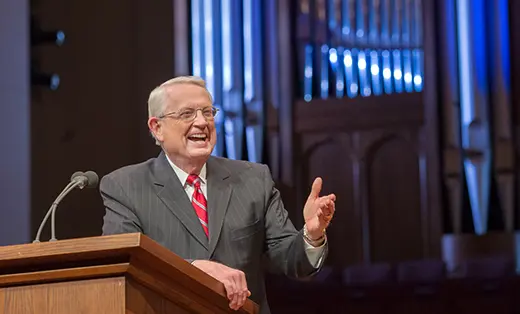This Should Be Me
By Insight for Living
The sound of bleating lambs and shuffling footsteps filled the temple. With three trumpet blasts, the priests announced the start of the Passover sacrifices. Worshipers responded to the priests’ psalms with “Hallelujahs” as each man offered his household’s sacrifice to God. As the disciple John raised the knife to the throat of the lamb he’d brought, he thought, “This should be me.” With one quick motion of his hand, the lamb’s bleating stopped, and John watched its blood drain into the bowl held by the priest. The priest emptied the bowl at the base of the altar, adding to the smell of blood that hung in the air.
Christ’s Final Passover
Why did a lamb have to be sacrificed on Passover? The Jewish feast was meant to remember and retell the story of Israel’s Exodus from Egypt. The lamb sacrificed that afternoon became the main course of the Passover meal, representing the price paid for the protection of Israel and their redemption from Egypt. God had “passed over” the homes of those Hebrews who had applied the lamb’s blood to their doorways (Exodus 12:12-27). With the lamb, the Jews also ate unleavened bread and bitter herbs, recalling the agony of bondage in Egypt and the food God provided for the Israelites during the Exodus (12:39). By partaking of the sacrificed lamb, the Hebrews not only remembered, they also retold the Passover story to others.
Yet on the night John partook of the Passover lamb with Jesus and the other disciples, things changed. Although Jewish custom prohibited eating anything after the Passover meal, Jesus broke sharply with tradition. He took bread, gave thanks, and said to His disciples, “Take and eat. This is My body” (see Mark 14:22). John partook with the rest, then Jesus took up the third of four cups of wine traditionally drunk at the Passover, the “cup of redemption.” To John’s surprise, their Rabbi said, “This is My blood of the covenant, which is poured out for many” (14:24). The traditional fourth cup—the “cup of consummation”—remained untouched. Jesus explained, “I will never again drink of the fruit of the vine until that day when I drink it new in the kingdom of God” (14:25).
In remembering and retelling the Hebrew Passover, Christ followed the requirements of the law, but He transformed and fulfilled the meaning of the lamb, the bread, and the wine. However, one thing remained the same: the need for a substitute as a sacrifice in place of the guilty sinner.
Christ Our Passover
The following day Jesus was brutalized and executed on a Roman cross. To those who watched, the murder seemed senseless, but from God’s perspective it completely paid the cost of redemption. Isaiah had prophesied that, like a lamb led to the slaughter, the Messiah would be pierced for our transgressions, and the punishment due us would fall upon Him (Isaiah 53:5-7). Paul said that Christ Himself is the Passover lamb, sacrificed for our sins (1 Corinthians 5:7). All who consider the sufferings of Jesus should be haunted by these four words: “This should be me.”
The Bible says that all have sinned and deserve one punishment: death. The blood, gore, stench, and wails of the animal sacrifices reminded Old Testament Israelites daily of the wages of sin and cost of redemption. But Paul told us the good news that comes through Christ, the sacrificial Passover Lamb who died to forgive all of our sins: “For the wages of sin is death, but the free gift of God is eternal life in Christ Jesus our Lord” (Romans 6:23).
Making Christ Your Passover
In the Old Testament remembering meant more than just thinking; it meant responding with specific actions. During this Easter season, how will you remember and retell Christ’s Passover story?
Perhaps your church has a special service of remembrance, partaking of the Lord’s Supper or retelling the story of Good Friday and Easter through music or drama. Maybe you have a special family tradition that centers on Christ and His final payment for sin as the spotless Lamb of God. There are many great opportunities for you to remember and retell the story through Scripture and discussion on specific days of Easter week.
Like the Hebrews during Passover, your own tangible expression of remembrance and retelling will focus your heart away from kitschy Easter eggs and pastel bunnies toward the cleansing blood of the Lamb, “for Christ our Passover . . . has been sacrificed” (1 Corinthians 5:7). This year, center your thoughts and actions on the true meaning of the Hebrew Passover, applying the blood of Christ to the doorposts of your life with the proper attitude: “This should be me.”
Adapted from Michael J. Svigel and Suzanne Keffer, “This Should Be Me,” Insights (March 2005): 1-2. Copyright © 2005 by Insight for Living. All rights reserved worldwide.
About the author
![]() Insight for Living
Insight for Living
